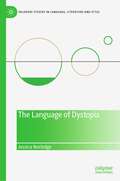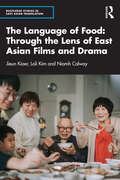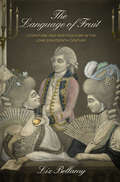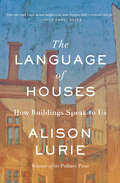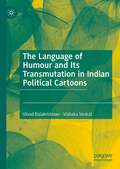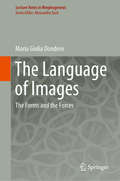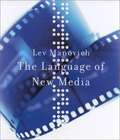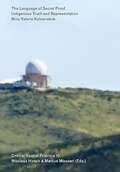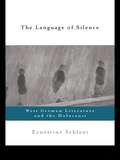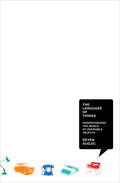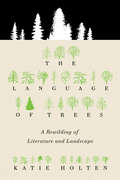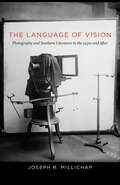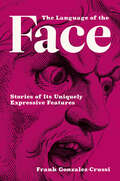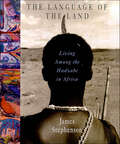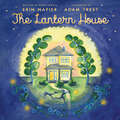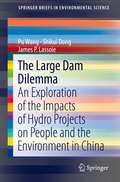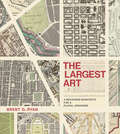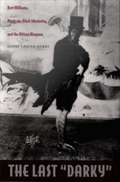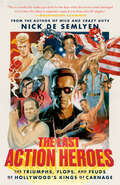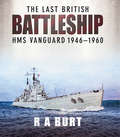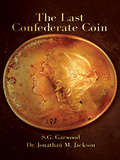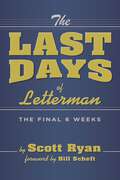- Table View
- List View
The Language of Dystopia (Palgrave Studies in Language, Literature and Style)
by Jessica NorledgeThis book presents an extended account of the language of dystopia, exploring the creativity and style of dystopian narratives and mapping the development of the genre from its early origins through to contemporary practice. Drawing upon stylistic, cognitive-poetic and narratological approaches, the work proposes a stylistic profile of dystopia, arguing for a reader-led discussion of genre that takes into account reader subjectivity and personal conceptualisations of prototypicality. In examining and identifying those aspects of language that characterise dystopian narratives and the experience of reading dystopian fictions, the work discusses in particular the manipulation and construction of dystopian languages, the conceptualisation of dystopian worlds, the reading of dystopian minds, the projection of dystopian ethics, the unreliability of dystopian refraction, and the evolution and hybridity of the dystopian genre.
The Language of Flowers: A Fully Illustrated Compendium of Meaning, Literature, and Lore for the Modern Romantic
by Odessa BegayWith gorgeous full-color illustrations, ornate decorative elements, lettering in metallic ink, and engaging text, The Language of Flowers: A Fully Illustrated Compendium of Meaning, Literature, and Lore for the Modern Romantic is a treasure for flower lovers. A sumptuous, contemporary anthology of 50 of the world's most storied and popular flowers, each of its entries offers insight to the meaning associated with the flower, and is a fascinating mix of foklore, classic mythology, literature, botanical information and popular culture. Following an introduction that provides a short history of the language of flowers, a fad which reached its peak during the reign of Queen Victoria, each uniquely illustrated and designed entry is an enjoyable read full of history and little-known facts. Here is the story of Tulipmania; how the pansy got its "face," and why the most particular pollination process of a certain orchid has made the vanilla bean a very dear commodity. You'll also dicover how Christian Dior's passion for lily of the valley inspired his classic perfume Diorissimo and its extraordinary bottle; why Oscar Wilde had a penchant for wearing green carnations in his lapel; and how Greeks and Romans believed snapdragons could ward off witchcraft, so they planted them at entryways to their homes. With more than a dozen two-page paintings evoking the romance of noteworthy Victorian gardens and symbolic bouquets, a cross-referenced index of flowers and meanings, and suggestions for further reading, this book is a must for lovers of floriology and Victoriana.
The Language of Food: Through the Lens of East Asian Films and Drama (Routledge Studies in East Asian Translation)
by Jieun Kiaer Loli Kim Niamh CalwayThe Language of Food: Through the Lens of East Asian Films and Drama invites readers into the fascinating world where food culture and language intersect, revealing how each dish communicates beyond mere taste.Through East Asian films and television shows, this book uncovers the rich tapestry of 'food languages' embedded within East Asian cultures. Divided into three parts – Base, Ingredients, and Seasoning – this book provides a structured exploration of this phenomenon. The Base section offers philosophical and historical context, while the Ingredients section delves deeper into specific themes, using examples from film and television drama to illustrate the nuanced communication inherent in food culture. Finally, the book is 'seasoned' with linguistic insights and a practical food words glossary, aiding readers in navigating the intricate verbal and cultural nuances at play. This illuminating resource goes beyond the realm of food itself, offering a profound understanding of how each dish carries its language, enriching communication and deepening cultural connections.This book will captivate students and researchers of East Asian languages, media studies, film studies, food studies, and Korean Wave studies and anyone intrigued by the intricate relationship between food and language.
The Language of Fruit: Literature and Horticulture in the Long Eighteenth Century (Penn Studies in Landscape Architecture)
by Liz BellamyIn The Language of Fruit, Liz Bellamy explores how poets, playwrights, and novelists from the Restoration to the Romantic era represented fruit and fruit trees in a period that saw significant changes in cultivation techniques, the expansion of the range of available fruit varieties, and the transformation of the mechanisms for their exchange and distribution. Although her principal concern is with the representation of fruit within literary texts and genres, she nevertheless grounds her analysis in the consideration of what actually happened in the gardens and orchards of the past.As Bellamy progresses through sections devoted to specific literary genres, three central "characters" come to the fore: the apple, long a symbol of natural abundance, simplicity, and English integrity; the orange, associated with trade and exchange until its "naturalization" as a British resident; and the pineapple, often figured as a cossetted and exotic child of indulgence epitomizing extravagant luxury. She demonstrates how the portrayal of fruits within literary texts was complicated by symbolic associations derived from biblical and classical traditions, often identifying fruit with female temptation and sexual desire. Looking at seventeenth-century poetry, Restoration drama, eighteenth-century georgic, and the Romantic novel, as well as practical writings on fruit production and husbandry, Bellamy shows the ways in which the meanings and inflections that accumulated around different kinds of fruit related to contemporary concepts of gender, class, and race.Examining the intersection of literary tradition and horticultural innovation, The Language of Fruit traces how writers from Andrew Marvell to Jane Austen responded to the challenges posed by the evolving social, economic, and symbolic functions of fruit over the long eighteenth century.
The Language of Houses: How Buildings Speak to Us
by Alison LurieHow do the spaces we inhabit affect us—and reflect us? A Pulitzer Prize–winning author explores architecture, in this insightful, &“breezy&” read (The Washington Post). In 1981, Alison Lurie published The Language of Clothes, a meditation on costume and fashion as an expression of history, social status and individual psychology. Amusing, enlightening and full of literary allusion, the book was highly praised and widely anthologized. Now Lurie has returned with a companion book, The Language of Houses, a lucid, provocative and entertaining look at how the architecture of buildings and the spaces within them both reflect and affect the people who inhabit them. Schools, churches, government buildings, museums, prisons, hospitals, restaurants, and of course, houses and apartments—all of them speak to human experience in vital and varied ways.The Language of Houses discusses historical and regional styles and the use of materials such as stone and wood and concrete, as well as contemplating the roles of stairs and mirrors, windows and doors, tiny rooms and cathedral-like expanses, illustrating its conclusions with illuminating literary references and the comments of experts in the field. Accompanied by lighthearted original drawings, The Language of Houses is an essential and highly entertaining new contribution to the literature of modern architecture.
The Language of Humour and Its Transmutation in Indian Political Cartoons
by Vinod Balakrishnan Vishaka VenkatThis book develops a model to examine the language of humour, which is multimodal and accounts for the possibility of transmutation of humour as it is performed through editorial cartoons. By transmutation is meant the transition in the language of humour when it crosses its own boundaries to provoke unprecedented reactions resulting in offensiveness, disappointment or hurt sentiment. The transmutability about the language of humour points to its inherently diabolical nature which manifests in the performance of controversial cartoons. The model is built by borrowing theoretical cues from Roman Jakobson, Roland Barthes, George Lakoff and Mark Johnson. The integrated model, then, is developed to examine the cartoons which were recommended for deletion by the Thorat Committee, following a cartoon controversy in India. Through the cartoon analysis, the model discerns the significance of context and temporality in determining the impact of humour. It also examines how the ethics of humour; the blurred lines of political correctness and incorrectness are dictated by the political atmosphere and the power dynamics.
The Language of Images: The Forms and the Forces (Lecture Notes in Morphogenesis)
by Maria Giulia DonderoThis book deals with two fundamental issues in the semiotics of the image. The first is the relationship between image and observer: how does one look at an image? To answer this question, this book sets out to transpose the theory of enunciation formulated in linguistics over to the visual field. It also aims to clarify the gains made in contemporary visual semiotics relative to the semiology of Roland Barthes and Emile Benveniste. The second issue addressed is the relation between the forces, forms and materiality of the images. How do different physical mediums (pictorial, photographic and digital) influence visual forms? How does materiality affect the generativity of forms? On the forces within the images, the book addresses the philosophical thought of Gilles Deleuze and René Thom as well as the experiment of Aby Warburg’s Atlas Mnemosyne. The theories discussed in the book are tested on a variety of corpora for analysis, including both paintings and photographs, taken from traditional as well as contemporary sources in a variety of social sectors (arts and sciences). Finally, semiotic methodology is contrasted with the computational analysis of large collections of images (Big Data), such as the “Media Visualization” analyses proposed by Lev Manovich and Cultural Analytics in the field of Computer Science to evaluate the impact of automatic analysis of visual forms on Digital Art History and more generally on the image sciences.
The Language of Life and Death
by William LabovWe share the experience of others through the stories they tell of the crucial events in their lives. This book provides a rich range of narratives that grip the reader's attention together with an analysis of how it is done. While remaining true to the facts, narrators use linguistic devices to present themselves in the best possible light and change the listener's perception of who is to blame for what has occurred. William Labov extends his widely used framework for narrative analysis to matters of greatest human concern: the danger of death, violence, premonitions, and large-scale community conflicts. The book also examines traditional epic and historical texts, from Herodotus and the Old Testament to Macaulay, showing how these literary genres draw upon the techniques of personal narratives. Not only relevant to students of narratology, discourse and sociolinguistics, this book will be rewarding reading for anyone interested in the human condition.
The Language of New Media
by Lev ManovichLev Manovich offers the first systematic and rigorous theory of new media. He places new media within the histories of visual and media cultures of the last few centuries.
The Language of Secret Proof: Indigenous Truth and Representation
by Nina Valerie KolowratnikNew spatial notational systems for protecting and regaining Indigenous lands in the United States. In The Language of Secret Proof, Nina Valerie Kolowratnik challenges the conditions under which Indigenous rights to protect and regain traditional lands are currently negotiated in United States legal frameworks. This tenth volume in the Critical Spatial Practice series responds to the urgent need for alternative modes of evidentiary production by introducing an innovative system of architectural drawing and notation. Kolowratnik focuses on the double bind in which Native Pueblo communities in the United States find themselves when they become involved in a legal effort to reclaim and protect ancestral lands; the process of producing evidence runs counter to their structural organization around oral history and cultural secrecy. The spatial notational systems developed by Kolowratnik with Hemish tribal members from northern New Mexico and presented in this volume are an attempt to produce evidentiary documentation that speaks Native truths while respecting demands on secrecy. These systems also attempt to instigate a dialogue where there currently is none, working to deconstruct the fixed opposition between secrecy and disclosure within Western legal systems.
The Language of Silence: West German Literature and the Holocaust
by Ernestine SchlantFocusing on individual authors from Heinrich Boll to Gunther Grass, Hermann Lenz to Peter Schneider, The Language of Silence offers an analysis of West German literature as it tries to come to terms with the Holocaust and its impact on postwar West German society. Exploring postwar literature as the barometer of Germany's unconsciously held values as well as of its professed conscience, Ernestine Schlant demonstrates that the confrontation with the Holocaust has shifted over the decades from repression, circumvention, and omission to an open acknowledgement of the crimes. Yet even today a 'language of silence' remains since the victims and their suffering are still overlooked and ignored. Learned and exacting, Schlant's study makes an important contribution to our understanding of postwar German culture.
The Language of Things: Understanding the World of Desirable Objects
by Deyan SudjicA brilliant exposé of the interaction between art, design, and commerce. In ?The Language of Things, ?the director of London's Design Museum charts our relationship with all things designed. With scintillating wit and an eye for the pleasures and dangers of rampant consumerism, Deyan Sudjic takes us from luxury car commercials to glossy advertisements for seasonal variations of the Prada purse to the hype surrounding the latest version of the iPhone, exploring how we are manipulated and seduced by our possessions. Who would've thought that it's the subtle visual similarity between the Volkswagen Golf GTI and the barrel of an automatic pistol that makes people want to get behind the wheel? And why is it that digital cameras in cell phones "click" even though they don't have a shutter? Sudjic's illuminating argument will resound with anyone who has ever been affected by how things look--lured, in other words, by the powerful siren call of design.
The Language of Trees: A Rewilding Of Literature And Landscape
by Katie HoltenA LitHub Most Anticipated Book of 2023 “A masterpiece. Katie Holten's tree alphabet is a gift to the printed world.”—Max Porter, author of Grief is a Thing with Feathers Inspired by forests, trees, leaves, roots, and seeds, The Language of Trees: A Rewilding of Literature and Landscape invites readers to discover an unexpected and imaginative language to better read and write the natural world around us and reclaim our relationship with it. In this gorgeously illustrated and deeply thoughtful collection, Katie Holten gifts readers her tree alphabet and uses it to masterfully translate and illuminate beloved lost and new, original writing in praise of the natural world. With an introduction from Ross Gay, and featuring writings from over fifty contributors including Ursula K. Le Guin, Ada Limón, Robert Macfarlane, Zadie Smith, Radiohead, Aimee Nezhukumatathil, James Gleick, Elizabeth Kolbert, Plato, and Robin Wall Kimmerer, Holten illustrates each selection with an abiding love and reverence for the magic of trees. She guides readers on a journey from creation myths and cave paintings to the death of a 3,500-year-old cypress tree, from Tree Clocks in Mongolia and forest fragments in the Amazon to the language of fossil poetry, unearthing a new way to see the natural beauty all around us and an urgent reminder of what could happen if we allow it to slip away. The Language of Trees considers our relationship with literature and landscape, resulting in an astonishing fusion of storytelling and art and a deeply beautiful celebration of trees through the ages.
The Language of Vision: Photography and Southern Literature in the 1930s and After (Southern Literary Studies)
by Joseph R. MillichapThe Language of Vision celebrates and interprets the complementary expressions of photography and literature in the South. Southern imagery and text affect one another, explains Joseph R. Millichap, as intertextual languages and influential visions. Focusing on the 1930s, and including significant works both before and after this preeminent decade, Millichap uncovers fascinating convergences between mediums, particularly in the interplay of documentary realism and subjective modernism.Millichap's subjects range from William Faulkner's fiction, perhaps the best representation of literary and graphic tensions of the period, and the work of other major figures like Robert Penn Warren and Eudora Welty to specific novels, including Ralph Ellison's Invisible Man and James Agee's Let Us Now Praise Famous Men. Fleshing out historical and cultural background as well as critical and theoretical context, Millichap shows how these texts echo and inform the visual medium to reveal personal insights and cultural meanings. Warren's fictions and poems, Millichap argues, redefine literary and graphic tensions throughout the late twentieth century; Welty's narratives and photographs reinterpret gender, race, and class; and Ellison's analysis of race in segregated America draws from contemporary photography. Millichap also traces these themes and visions in Natasha Trethewey's contemporary poetry and prose, revealing how the resonances of these artistic and historical developments extend into the new century. This groundbreaking study reads southern literature across time through the prism of photography, offering a brilliant formulation of the dialectic art forms.
The Language of the Face: Stories of Its Uniquely Expressive Features
by Frank Gonzalez-CrussiA broad and riveting cultural history of physiognomy, exploring how the desire to divine deeper meaning from our looks has compelled humans for millennia.How do you read a face? For thousands of years, artists, philosophers, and scientists have explored the question of what our outer appearance might reveal about our inner selves. In The Language of the Face, a marvelously comprehensive exploration of the pseudoscience of physiognomy, Frank Gonzalez-Crussi considers over a millennium&’s worth of primary sources to paint a splendid portrait of the face&’s cultural symbology. Gonzalez-Crussi, an acclaimed pathologist and writer, transcends disciplines with a singular balance of depth and levity. Blending literary analysis of both ancient and modern texts with the insights of medical anthropology, his narrative ranges from an investigation into &“nasal semiotics&”—a subject whose legacy persists most destructively in myths of racial typology—to equally astute analyses of the thrills of the erotic kiss, the diagnostic art of astrology, and the enlightening qualities of supposed ugliness. While our appearances may ultimately be no more than surface-level signifiers of identity, Gonzalez-Crussi&’s work is anything but superficial in its treatment of the consummately human urge to find profound meaning amidst seemingly arbitrary attributes. As rigorously researched as it is wildly entertaining, The Language of the Face is a vibrant contribution to both the emerging field of medical humanities and the popular understanding of aesthetics and physiology at large.
The Language of the Land: Living Among the Hadzabe in Africa
by James StephensonA rare adventure with the last Stone Age hunting and gathering tribe in Africa.In 1997 James Stephenson arranged to have almost a full year free, a year he wanted to spend among the Hadzabe in Tanzania. He had visited these people several times previously and with every trip his fascination with them deepened, for the Hadzabe are the last hunters and gatherers still living a traditional life in East Africa.At the age of 27, Stephenson intended to spend the year living among the Hadzabe, and, more importantly, living their life, hunting what they hunted, eating what they ate, participating in their dances and ceremonies, consulting with their medicine men and learning their myths and dreams.Armed only with his camera, his art supplies and the open-hearted courage of youth, he set out to visit with a people who have changed little since the Stone Age. He wanted to glimpse the world as they perceived it and learn the wisdom they had wrestled from the land. The Language of the Land, the account of his adventure and what he learned, is travel writing at its best.
The Lantern House
by Erin NapierFrom the nationally beloved co-host of the #1 hit show Home Town comes the quintessential celebration of home. Imagine a house's early days as a home: A young family builds a picket fence and plants flowers in its yard, children climb the magnolia tree and play the piano in the living room, and there is music inside the house for many happy years. But what will happen when its windows grow dark, its paint starts to crumble, and its boards creak in the winter wind? The house dreams of a family who will love it again...and one day, a new story will emerge from within its walls. In this modern classic, Erin Napier&’s lyrical prose and Adam Trest&’s warm and comforting paintings deeply evoke the soul of a house cherishing the seasons of life and discovering the joy of rebirth.
The Large Dam Dilemma
by Pu Wang Shikui Dong James P. LassoieLarge dam construction has significant environmental and social impacts at different scales. As the largest developing country in the world, China has built about half of the world's large dams, and more are expected to be built over the next two decades to meet the country's rapidly growing demand for energy. This book summarizes and updates information about the history, distribution, functions, and impacts of large dams, both globally and at China's national level. It then addresses the environmental and social-economic impacts of large dams in China with particular emphasis on the impacts of large dams on relocated people and associated compensation policies. Lastly, it introduces an integrated ecological and socio-economic study conducted in areas affected by dams along the Upper Mekong River, China. This book has the following three goals. The first goal is to summarize and update information on large dams globally and at China's national level (Ch. 2). We examine large dam problems from different perspectives, ranging from their spatial and temporal distributions and their environmental and social impacts, to discussions and debates centered on them. We also incorporate the results of an empirical investigation of the environmental and socio-economic impacts of large dams on the Upper Mekong River, China, and draw conclusions out of the analysis (Chs. 3 & 4). Our second goal is to provide an analysis framework to help understand the environmental and social-economic impacts of dam construction and the resulting environmental degradations and social inequities at different scales (Chs. 3 & 4), as well as to offer recommendations for mitigating these impacts within China's socio-political context (Ch. 5). The significant environmental effects resulting from dam construction include damage to ecological integrity and loss of biological diversity. The most significant social consequences brought by dam projects are their negative impacts on relocated people. Our analysis framework provides approaches to help comprehensively understand these impacts. Our third goal is to provide clues and suggestions for further studies of large dam problems both globally and in China (Ch. 5). The construction of large dams is proceeding rapidly in different parts of the world despite the heated debates on whether they should be built at all. The decision-making process related to building large dams involves considerations of economic viability, environmental sustainability, and social equity. Therefore, interdisciplinary collaborations are required in large dam research and development projects in order to reconcile the interests of different stakeholders and avoid harming ecosystems, biodiversity, and human welfare. Overall, we hope our book facilitates future examinations of large dams by providing summaries of existing data and research related to large dams, and offering a framework for better understanding and analyzing their environmental and social impacts.
The Largest Art: A Measured Manifesto for a Plural Urbanism (The\mit Press Ser.)
by Brent D. RyanWhy urban design is larger than architecture: the foundational qualities of urban design, examples and practitionersUrban design in practice is incremental, but architects imagine it as scaled-up architecture—large, ready-to-build pop-up cities. This paradox of urban design is rarely addressed; indeed, urban design as a discipline lacks a theoretical foundation. In The Largest Art, Brent Ryan argues that urban design encompasses more than architecture, and he provides a foundational theory of urban design beyond the architectural scale. In a “declaration of independence” for urban design, Ryan describes urban design as the largest of the building arts, with qualities of its own.Ryan distinguishes urban design from its sister arts by its pluralism: plural scale, ranging from an alleyway to a region; plural time, because it is deeply enmeshed in both history and the present; plural property, with many owners; plural agents, with many makers; and plural form, with a distributed quality that allows it to coexist with diverse elements of the city. Ryan looks at three well-known urban design projects through the lens of pluralism: a Brancusi sculptural ensemble in Romania, a Bronx housing project, and a formally and spatially diverse grouping of projects in Ljubljana, Slovenia. He revisits the thought of three plural urbanists working between 1960 and 1980: David Crane, Edmund Bacon, and Kevin Lynch. And he tells three design stories for the future, imaginary scenarios of plural urbanism in locations around the world.Ryan concludes his manifesto with three signal considerations urban designers must acknowledge: eternal change, inevitable incompletion, and flexible fidelity. Cities are ceaselessly active, perpetually changing. It is the urban designer's task to make art with aesthetic qualities that can survive perpetual change.
The Last "Darky": Bert Williams, Black-On-Black Minstrelsy, and the African Diaspora
by Louis Chude-SokeiThe Last "Darky" establishes Bert Williams, the comedian of the late nineteenth century and early twentieth, as central to the development of a global black modernism centered in Harlem's Renaissance. Before integrating Broadway in 1910 via a controversial stint with the Ziegfeld Follies, Williams was already an international icon. Yet his name has faded into near obscurity, his extraordinary accomplishments forgotten largely because he performed in blackface. Louis Chude-Sokei contends that Williams's blackface was not a display of internalized racism nor a submission to the expectations of the moment. It was an appropriation and exploration of the contradictory and potentially liberating power of racial stereotypes. Chude-Sokei makes the crucial argument that Williams's minstrelsy negotiated the place of black immigrants in the cultural hotbed of New York City and was replicated throughout the African diaspora, from the Caribbean to Africa itself. Williams was born in the Bahamas. When performing the "darky," he was actually masquerading as an African American. This black-on-black minstrelsy thus challenged emergent racial constructions equating "black" with African American and marginalizing the many diasporic blacks in New York. It also dramatized the practice of passing for African American common among non-American blacks in an African American-dominated Harlem. Exploring the thought of figures such as Booker T. Washington, W. E. B. Du Bois, Marcus Garvey, and Claude McKay, Chude-Sokei situates black-on-black minstrelsy at the center of burgeoning modernist discourses of assimilation, separatism, race militancy, carnival, and internationalism. While these discourses were engaged with the question of representing the "Negro" in the context of white racism, through black-on-black minstrelsy they were also deployed against the growing international influence of African American culture and politics in the twentieth century.
The Last Action Heroes: The Triumphs, Flops, and Feuds of Hollywood's Kings of Carnage
by Nick de SemlyenThe behind-the-scenes story of the action heroes who ruled 1980s and &’90s Hollywood and the beloved films that made them stars, including Die Hard, First Blood, The Terminator, and more.&“This book takes you so close to the action that you can smell the sweat, cigar smoke, and bad cologne that brought these movies to life.&”—Paul ScheerThe Last Action Heroes opens in May 1990 in Cannes, with Arnold Schwarzenegger and Sylvester Stallone waltzing together, cheered on by a crowd of famous faces. After years of bitter combat—Stallone once threw a bowl of flowers at Schwarzenegger&’s head, and the body count in Schwarzenegger&’s Commando was increased so the film would &“have a bigger dick than Rambo&”—the world&’s biggest action stars have at last made peace.In this wildly entertaining account of the golden age of the action movie, Nick de Semlyen charts Stallone and Schwarzenegger&’s carnage-packed journey from enmity to friendship against the backdrop of Reagan&’s America and the Cold War. He also reveals fascinating untold stories of the colorful characters who ascended in their wake: high-kickers Chuck Norris and Jackie Chan, glowering tough guys Dolph Lundgren and Steven Seagal, and quipping troublemakers Jean-Claude Van Damme and Bruce Willis. But as time rolled on, the era of the invincible action hero who used muscle, martial arts, or the perfect weapon to save the day began to fade. When Jurassic Park trounced Schwarzenegger&’s Last Action Hero in 1993, the glory days of these macho men—and the vision of masculinity they celebrated—were officially over.Drawing on candid interviews with the action stars themselves, plus their collaborators, friends, and foes, The Last Action Heroes is a no-holds-barred account of a period in Hollywood history when there were no limits to the heights of fame these men achieved, or to the mayhem they wrought, on-screen and off.
The Last Bookseller: A Life in the Rare Book Trade
by Gary GoodmanA wry, unvarnished chronicle of a career in the rare book trade—now in paperback When Gary Goodman wandered into a run-down, used-book shop that was going out of business in East St. Paul in 1982, he had no idea the visit would change his life. He walked in as a psychiatric counselor and walked out as the store&’s new owner. In The Last Bookseller Goodman describes his sometimes desperate, sometimes hilarious career as a used and rare book dealer in Minnesota—the early struggles, the travels to estate sales and book fairs, the remarkable finds, and the bibliophiles, forgers, book thieves, and book hoarders he met along the way. Here we meet the infamous St. Paul Book Bandit, Stephen Blumberg, who stole 24,000 rare books worth more than fifty million dollars; John Jenkins, the Texas rare book dealer who (probably) was murdered while standing in the middle of the Colorado River; and the eccentric Melvin McCosh, who filled his dilapidated Lake Minnetonka mansion with half a million books. In 1990, with a couple of partners, Goodman opened St. Croix Antiquarian Books in Stillwater, one of the Twin Cities region&’s most venerable bookshops until it closed in 2017. This store became so successful and inspired so many other booksellers to move to town that Richard Booth, founder of the &“book town&” movement in Hay-on-Wye in Wales, declared Stillwater the First Book Town in North America. The internet changed the book business forever, and Goodman details how, after 2000, the internet made stores like his obsolete. In the 1990s, the Twin Cities had nearly fifty secondhand bookshops; today, there are fewer than ten. As both a memoir and a history of booksellers and book scouts, criminals and collectors, The Last Bookseller offers an ultimately poignant account of the used and rare book business during its final Golden Age.
The Last British Battleship: HMS Vanguard, 1946–1960
by R. A. Burt&“Lots of information on the ship&’s design, weapons, armor, refits, and service career, along with the Royal Cruise of 1947.&” —Model Ship World The ninth HMS Vanguard, bearing one of the most illustrious names in the Royal Navy with honors from the Armada to Jutland, was the last and largest of Britain&’s battleships and was commissioned in 1946. Her design evolved from the King George V class and incorporated much of the fully developed design for the two battleships, Lion and Temeraire, that were laid down in 1939 but never completed. At 813ft length overall and 42,300 tons, she was the last battleship to be built for the Royal Navy and the only ship of her class. She was built during the Second World War and incorporated existing twin 15in mountings, and was part of the Royal Navy&’s response to the combined and increasing number of German and Japanese battleships in the early 1940s. Immediately recognizable by her transom stern and high flared bow, she had fine sea keeping ability. Her appearance after the end of hostilities, however, and her huge crew requirements proved a conundrum for the Royal Navy, her most significant role being that of Royal Yacht during the royal family&’s tour of South Africa in 1947. She was broken up at Faslane in 1960. In this book her design, construction, and career are all covered. Armor, machinery, power plants and weaponry are examined in detail and the author has produced some 35 superb plans, profiles, and other line drawings. The text is further enhanced by the addition of some 80 photos, many in color, from his collection. R.A. Burt&’s earlier three volumes are regarded as definitive works on the subject of British battleships before 1945; with this new book he finally completes the story of the Dreadnought era, bringing to life the last of a magnificent type of vessel of which the world will not see again.
The Last Confederate Coin
by S. G. Garwood Dr Jonathan M. JacksonHistorical fiction based more on fact than fiction. The authors captured the brutality bestowed upon the soldiers who fought America's bloodiest war, the War Between the States (1861-1865). The story shows the bravery of the final crew of the CS Hunley, the first hunter-killer submarine, and the tragic ending of the love between Miss Queenie and Lt. Dixon, commander of the Hunley who died with his vessel after sinking the USS Housatonic off the coast of Charleston, South Carolina. The graphic descriptions of wartime combat, field hospitals, and life for men and women during the American Civil War, will surely elicit a wide-range of emotions within its readers. This is a must-read novel for Civil War aficionados, residents of the Lowcountry, and Charlestonians. --Wayne T. Dowdy, author of the novel, Unknown Innocence, and volumes of other writings, including his most popular blog, "Southern Pride-Waving a Confederate Flag."
The Last Days of Letterman
by Scott RyanA brilliants look behind the scenes at not only the making of a television show, but also the curtain call of one of America's greatest entertainers and the impact his impending departure will have on the many talented people who work so hard to put the show together but never -- until now -- got the credit they deserved.On May 20, 2015, Dave said, "Thank you and goodnight." The Foo Fighters sang "Everlong," and Late Show with David Letterman ended its run. The final six weeks of the series had guests like Julia Roberts, George Clooney, Oprah Winfrey, and the Obamas. All names you have heard many times. But it was the people behind the scenes who pulled off these twenty-eight unforgettable episodes of late-night television.Author Scott Ryan conducted over twenty interviews with the staffers of David Letterman. Most of the participants had never given interviews before. The writers, directors, producers, and stage managers offer a behind-the-scenes look at what it was like to work on these shows. Find out what it takes to write a Top Ten list, book a president for a guest spot, and what it was like working at the Ed Sullivan Theater.Long time Letterman writer Bill Scheft penned the foreword for the book. Included are over 100 color photos from staffers' personal collections, as well as publicity photos from the show. Get the first truly inside look at creating an episode of Late Show.Interviews with: Barbara Gaines - Executive Producer; Sheila Rogers - Supervising Producer/ Talent Executive; Randi Grossack - Associate Director; Kathy Mavrikakis, Supervising Producer; Rick Sheckman, Associate Producer; Brian Teta - Supervising Producer/Segment Producer; Sheryl Zelikson - Music Producer; Jay Johnson - Creative Director, Digital Media; Jerry Foley - Director; Michael Barrie - Writer; Lee Ellenberg - Writer; Jim Mulholland - Writer; Joe Grossman - Writer; Jeremy Weiner - Writer; Steve Young - Writer; Vincent Favale - Executive of Late Night Programing; Eddie Valk - Stage Manager; Bill Scheft - Writer; Janice Penino - Vice President, Human Resources; Jill Goodwin - Writer; and Mike Buczkiewicz - Senior Producer/Segment Producer; Rupert Jee - Hello Deli Owner.
